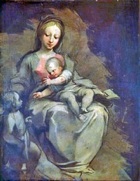Ventura Arcangelo di Salimbeni, who was born in Siena, was the half-brother of another important artist, Francesco Vanni. Both brothers were greatly influenced by Federico Barocci. According to Giovanni Baglioni, Ventura Salimbeni was among the artists at work in the Vatican Library for Pope Sixtus V in 1589. He seems to have had his own workshop in Rome by 1591, and he subsequently became one of the most appreciated artists of his time.
Cardinal Bonifazio Bevilacqua, the Papal Legate in Umbria in the early 17th century, commissioned two panels from him for San Pietro, Perugia (see below). Cardinal Bevilacqua subsequently nominated him for the Ordine dello Sperone d’Oro (a papal honour conferring the title Knight of the Golden Spur) and authorised him to call himself Cavalieri Bevilacqua.
Assisi
Frescoes in Santa Maria degli Angeli (ca. 1602)
Two of the frescoes in the vaults of the Cappella della Deposizione of Santa Maria degli Angeli, which belonged to the Breccia-Vigilanti family, are attributed to Ventura Salimbeni. He was documented in Perugia in 1602, and these frescoes also probably dates to around this time. They depict:
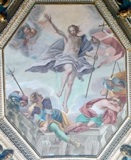

-
✴the Resurrection; and
-
✴Pope Innocent IV visiting the dying St Clare.
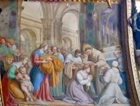
Frescoes in Palazzo Giacobetti Vallemani (ca. 1602)

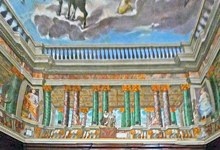
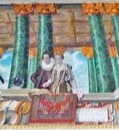
The frescoes of the Sala delle Feste of what is now Palazzo Giacobetti Vallemani are attributed to Ventura Salimbeni. The frescoed arms in this room belong to the Breccia-Vigilanti family, who probably built the palace and commissioned its original decoration. This family also owned the Cappella della Deposizione of Santa Maria degli Angeli (above), and the frescoes in the palace and the chapel were probably executed at about the same time.
This room is also known as the Sala degli Sposi, in reference to the couple frescoed on the fictive balcony. The original portraits of this couple (presumably the original owners from the Breccia and Vigilanti families) have been painted over, probably to depict the later owners, Count Paolo Giacobetti and Settimia della Genga.
The fresco on the ceiling is an allegory of the triumph of Virtue over Vice.
Foligno
Adoration of the shepherds (1610)
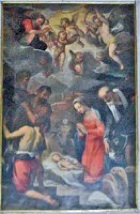
Crucifixion (17th century)
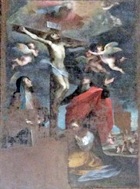
Marriage of the Virgin (1613)
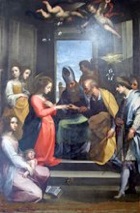
Perugia
Panels in San Pietro (1602)
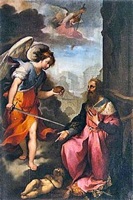
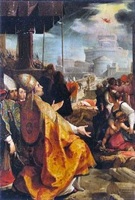
Cardinal Bevilacqua commissioned two panels from Ventura Salimbeni that are now in the right aisle of San Pietro:
-
✴the "Punishment of King David" (in the 7th bay), in which an angel invites David to choose between three punishments because he had taken a census of the nation of Israel, indicating his arrogance (on the left above); and
-
✴the "Vision of St Gregory the Great" (in the 9th bay), in which St Michael appeared to him above Mausoleum of Hadrian, sheathing his sword as a sign of the end of the plague of 590 in Rome. The Castel Sant' Angelo, which was subsequently built on the site, can be seen in the painting.
Cardinal Bevilacqua was so pleased that he invested Salimbeni with the Order of the Golden Spur and authorised him to call himself Cavalieri Bevilacqua.
Madonna and Child with St John the Baptist (ca. 1606)
